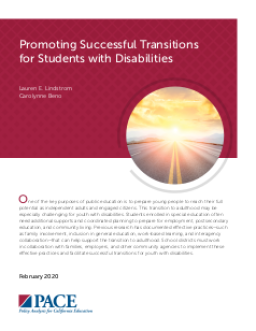Improvement Team Leads’ Perspectives on Fitting Improvement Work to Their Sites
Published
Summary
This chapter in an edited book focuses on the work of two improvement network hubs in California as they tried to support participating districts and schools to improve the proportion of students “on-track” for post-secondary success. California has a particular stake in figuring out how to support districts in consistently using continuous improvement (CI) to achieve measurable gains in student outcomes because state policy (e.g., Local Control Funding Formula, California’s Every Student Succeeds Act Plan) prescribes CI as the approach to improvement in its accountability system.
Insights and Strategies From Exemplar School Districts
Published
Summary
This resource guide addresses a key problem that many district and school leaders in California face: how to increase student enrollment and success in A–G courses to reduce equity gaps in college eligibility. Developed from a qualitative research study that examined the policies and practices of nine school districts in California with A–G completion rates surpassing the overall statewide rate, the guide presents strategies, tools, and resources to address challenges with A–G course alignment, counseling, and scheduling.
A Summary of the PACE Policy Research Panel
Published
Summary
Over 725,000 California K-12 students received special education services in 2018-19, but the system is not always equipped to serve them. Early screening, identification, and intervention, as well as better transitions, educator support, and mental/physical health services, need improvement. A Multi-Tiered System of Supports (MTSS) framework in schools could address SWDs' needs, but it requires additional resources and policy support to improve educator capacity and collaboration between agencies while systematizing data on SWDs.
Published
Summary
Students with disabilities should be included in programs that prepare them for life after high school. This can be achieved through a K-14 work-based learning model, which involves strengthening expectations, leveraging opportunities, and integrating supports. Early implementation of these actions is encouraged, along with specific policy recommendations for California.
Published
Summary
Preparing youth with disabilities for adulthood can be challenging, requiring additional supports and coordinated planning. Effective practices, such as family involvement, inclusion in general education, and interagency collaboration, can facilitate successful transitions to employment, postsecondary education, and community living. School districts must work with families, employers, and community agencies to implement these practices.
Views from the 2020 PACE/USC Rossier Poll
Published
Summary
In the run-up to 2020 elections, where do California voters stand on key education policy issues? This report examines findings and trends from the 2020 PACE/USC Rossier poll. Key findings include rising pessimism about California education and elected officials, continued concern about gun violence in schools and college affordability, and negative opinions about higher education. However, there is substantial support for increased spending, especially on teacher salaries.
Third-Year Results from Replications of the California Peninsula Academies
Published
Summary
Evaluation of 11 California high school academies in 1987-88 found positive in-school outcomes. Academies combine academic and vocational courses to reduce dropout rates. Graduation rates available for one grade-level cohort, with an estimated net benefit of $1.0-1.3 million from dropout prevention.
Second-Year Results from Replications of the California Peninsula Academies
Published
Summary
This article discusses the results of replicating the California Peninsula Academies model in 10 high schools. The model provides technical instruction in an occupational field, alongside core academic curriculum, and is designed to prevent dropouts. Evidence suggests that Academy students performed better in terms of grades and course credits compared to students in comparison groups, particularly at three sites.
A By-Product of Reform
Published
Summary
The Policy Analysis for California Education (PACE) Project provides nonpartisan information to policymakers about California's education system. Their "Conditions of Education in California" report is a yearly benchmark for policymakers. PACE also studies in-depth information on California's education system, including the impact of legislation on schools and the performance of students. Their research is widely distributed among education groups and citizens.
Published
Summary
This report discusses the decline in vocational education enrollment in California and its potential impact on noncollege-bound students' high school completion rates. Questions remain about the objectives of vocational education and whether it should prioritize skill training for entry-level jobs or emphasize academic skills for a working life of continual learning. PACE recommends a re-examination of curricular changes with a special focus on transitions occurring in vocational education due to enrollment declines and changes in the US job structure.
Published
Summary
The California Senate Office of Research has commissioned PACE to investigate how to expand public school programs to reduce dropout rates for high-risk students, particularly pregnant and parenting adolescents. The study involves examining secondary sources, conducting surveys of junior and senior high schools, unified and high school districts, and assessing implementation costs. The project is funded in part by the National Conference of State Legislators and the United States Office of Educational Research and Improvement.










